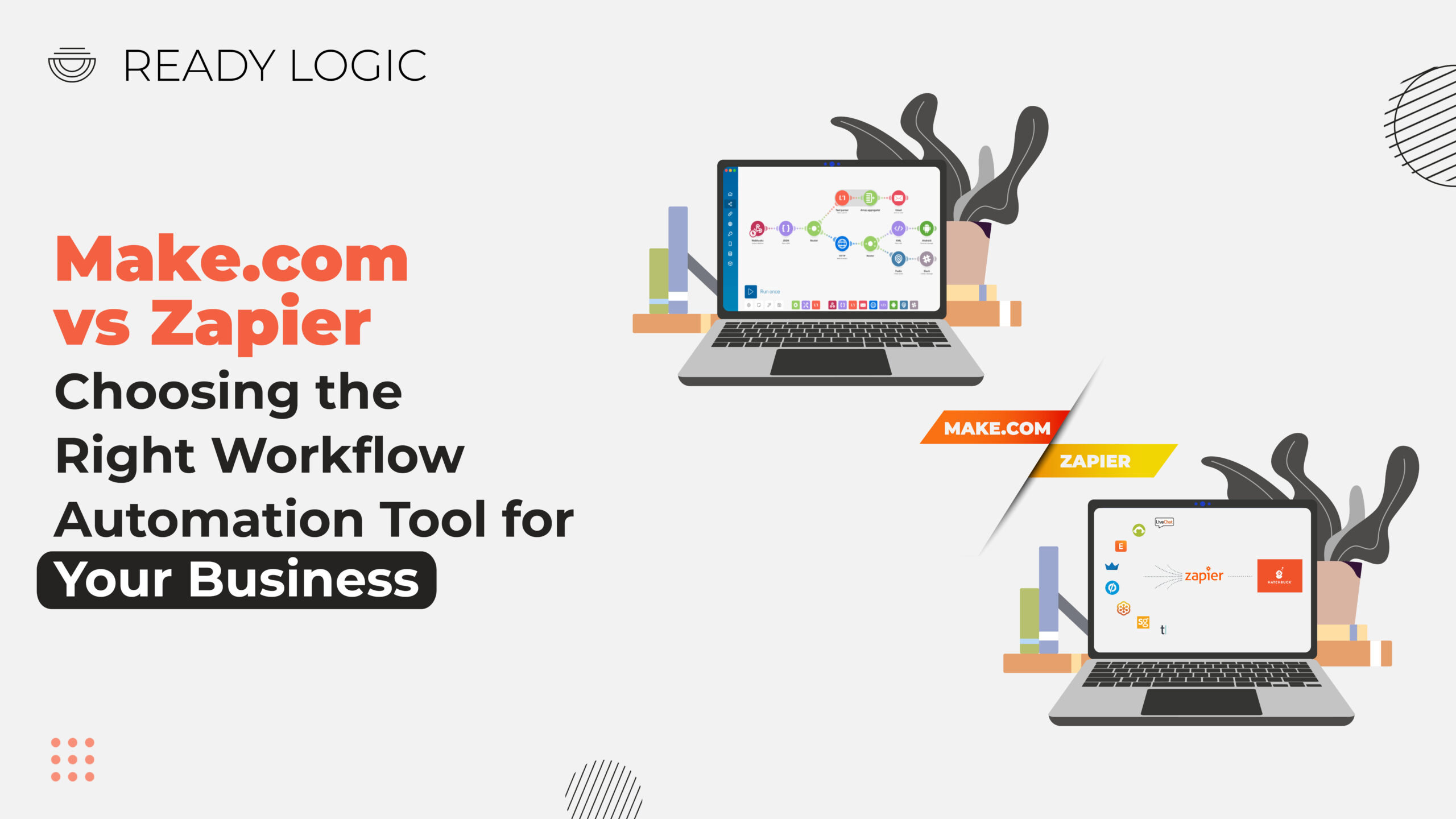Business process Automation has become essential rather than optional in today’s competitive landscape. As companies grow and digital systems become more complex, automation tools help streamline tasks, reduce errors, and save valuable time. Enter Make.com and Zapier, two of the most popular workflow automation tools on the market today.
These platforms have become essential in optimizing processes for businesses of all sizes, but how do they compare? Let’s break it down.
Understanding Workflow Automation Tools
Before diving into comparisons, it’s important to understand the core function of these tools and why they matter in modern business operations.
What Are Workflow Automation Tools?
Workflow automation tools are software platforms that connect various applications and services to perform repetitive tasks without human intervention. Think of them as digital glue binding tools like Gmail, Slack, and Google Sheets together to work in harmony.
Why Businesses Need Business Process Automation Tools
Automation tools help eliminate manual data entry, reduce delays in communication, and enhance productivity. For businesses aiming to scale or operate efficiently, automation tools like Make.com and Zapier are must-haves in the digital toolbox.
Make vs Zapier: A Feature Comparison
While both tools are designed for automation, their approach and capabilities differ significantly. Here’s how they stack up:
User Interface and Usability
Zapier offers a straightforward, no-frills interface that’s ideal for non-technical users. It’s quick to set up and easy to navigate.
Make.com, on the other hand, provides a more visual experience. Its drag-and-drop scenario builder can be more intuitive for visual learners and those dealing with complex workflows.
Number of Integrations and Supported Apps
Zapier integrates with over 6,000 apps, making it one of the most extensive platforms available. Make.com supports over 1,500 apps, focusing more on powerful use-case configurations rather than sheer volume.
Automation Complexity and Flexibility
Make.com allows for multi-step logic, conditions, data parsing, and webhooks, making it incredibly versatile for advanced users. Zapier shines in basic automations and linear workflows but struggles with more intricate scenarios.
Visual Scenario Building (Make.com) vs Trigger-Based Logic (Zapier)
Make.com’s visual scenario builder allows you to map out entire processes in one view, making it easy to manage complex logic. Zapier’s trigger-action model is linear, simpler, and great for single-use automations.
Performance and Reliability
Both platforms are reliable, but Zapier often edges out with slightly faster execution times and a longer track record of stability. Make.com, however, gives you more control over retry logic and error handling.
Pricing and Plans Overview
Cost is always a deciding factor, especially for small businesses and startups. Let’s see how Make.com and Zapier compare.
Free vs Paid Plans
Zapier’s free plan offers 100 tasks/month and limited multi-step Zaps.
Make.com’s free tier provides 1,000 operations/month and access to almost all features making it more generous for newcomers.
Cost-Effectiveness for SMBs and Enterprises
Make.com tends to be more affordable for businesses with complex needs due to its operation-based pricing. Zapier can get pricey quickly, especially when you scale beyond basic workflows.
Hidden Costs or Limitations to Know
Zapier limits data retention and access to premium apps on lower-tier plans. Make.com might charge more based on the number of operations, which can be hard to estimate initially.
Use Cases: Where Each Tool Shines
Depending on your needs, one tool may serve you better than the other.
Make.com for Developers and Complex Workflows
Make.com is ideal for developers or tech-savvy users building complex, multi-step workflows with conditions, filters, and HTTP modules.
Zapier for Quick, Simple Automations
Zapier excels when speed and simplicity are key. If you’re automating basic tasks like sending emails or updating spreadsheets, it’s the go-to.
Automated Marketing and Sales Workflows
Both tools integrate with CRMs and marketing platforms. Make.com offers more customization, while Zapier ensures faster, easier implementation for sales funnels and lead generation.
Business Process Automation Scenarios
From invoice generation to project management syncs, Make.com handles more elaborate automation needs, while Zapier handles straightforward “if this, then that” scenarios effortlessly.
Zapier Alternatives and Competitors
Zapier may be the market leader, but it’s not the only player.
Other Popular Automation Tools on the Market
Tools like Integrately, Pebbly Connect, and n8n are rising stars. They offer varying degrees of automation power, affordability, and ease of use.
How Make.com Stacks Up Against Other Zapier Competitors
Make.com holds its ground well, especially for users needing visual logic and deep customization. It’s often chosen by those who outgrow the limitations of Zapier and other simpler tools.
Choosing Between Make and Zapier for Your Business
Not sure which to pick? Your answer lies in understanding your business needs.
Business Size and Automation Needs
Startups and small businesses usually favor Zapier for its ease and speed. Mid-size and enterprise-level businesses often go with Make.com for its robustness.
Integration with Existing Business Process Software
Check which tool integrates better with your stack. If you’re using niche apps, Zapier might have broader compatibility. For ERP or custom systems, Make.com might offer better adaptability.
Technical Skill Requirements
Zapier requires little to no technical skill. Make.com may need some technical understanding, especially when building advanced scenarios or working with APIs.
Long-Term Scalability and Maintenance
Make.com provides more scalability with detailed workflow control. Zapier offers simpler scaling but might fall short on flexibility when your needs evolve.
Ready Logic’s Take: What We Recommend
At Ready Logic, we help clients simplify automation and choose the right tool based on their specific needs.
How Ready Logic Helps Clients Choose and Implement Automation Tools
We analyze your business processes and recommend the best automation strategy, whether it involves Zapier, Make.com, or another tool. Our team ensures seamless integration and training.
Success Stories Using Make.com and Zapier
From marketing agencies automating lead routing with Make.com to e-commerce shops syncing orders through Zapier, our clients have saved hundreds of hours and cut manual errors significantly.
Custom Automation Solutions Tailored to Your Needs
Whether you’re scaling fast or just starting out, we build and manage solutions that align with your long-term goals, so you focus on growing while we handle the automation.
Conclusion
Make.com vs Zapier, there’s no one-size-fits-all answer. If you need quick, simple automations, Zapier is your best bet. For complex workflows and deep integrations, Make.com takes the lead. Each tool suits a different kind of business. Zapier is perfect for teams who want to start automating today. Make.com is ideal for those ready to build intricate workflows that scale with them.
Let Ready Logic guide you to the perfect solution. We’re here to automate your success.
.
Make.com offers advanced, visual-based automation ideal for complex workflows, while Zapier is simpler and better suited for basic tasks.
Make.com tends to be more affordable, especially for users with complex automation needs, while Zapier can get expensive as usage scales.
Yes, though it requires rebuilding workflows. Ready Logic can assist in migrating your automations efficiently.
Popular options include Make.com, Integrately, Pabbly Connect, and n8n.
Absolutely! We offer consultation, setup, and maintenance for both platforms.



